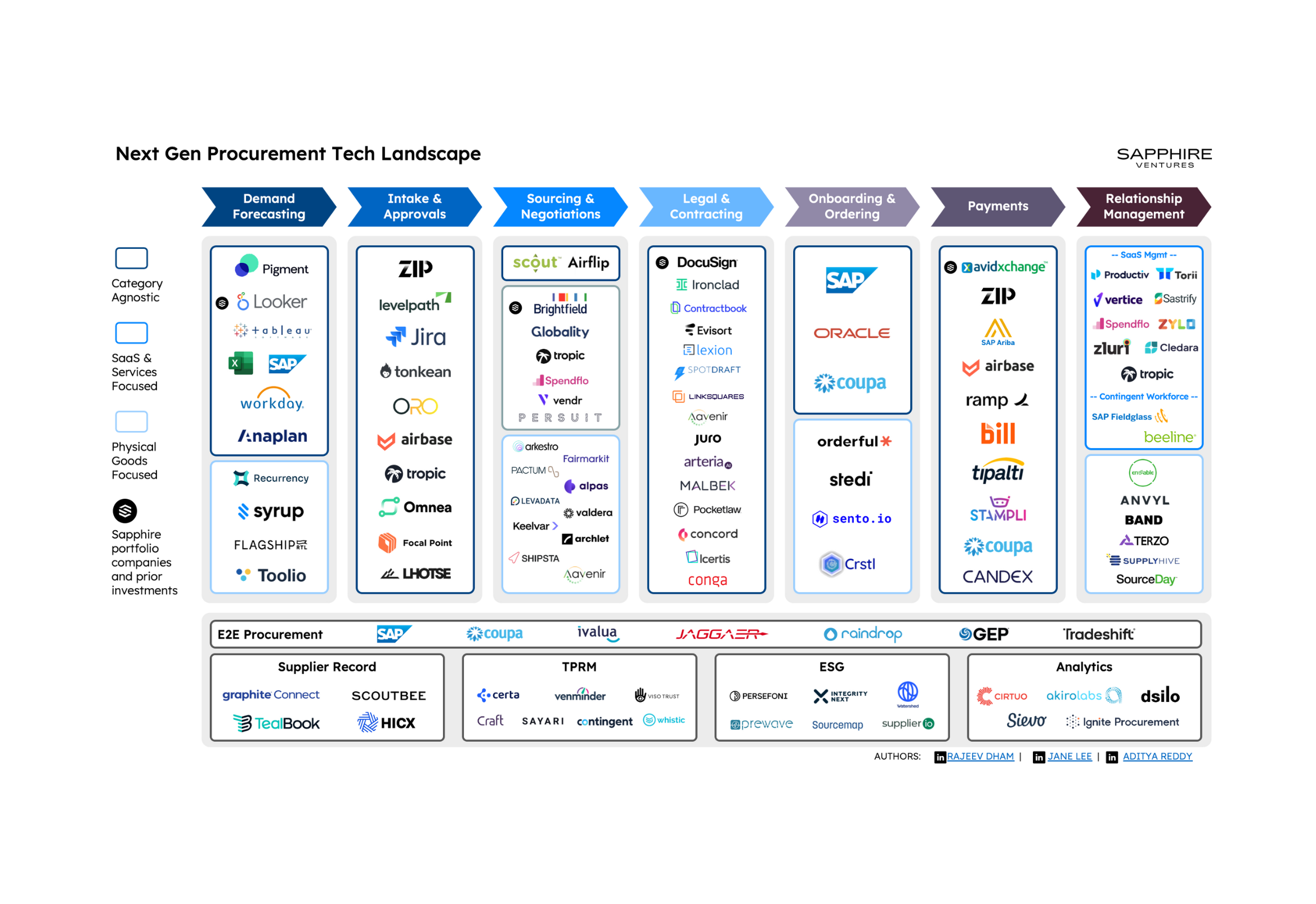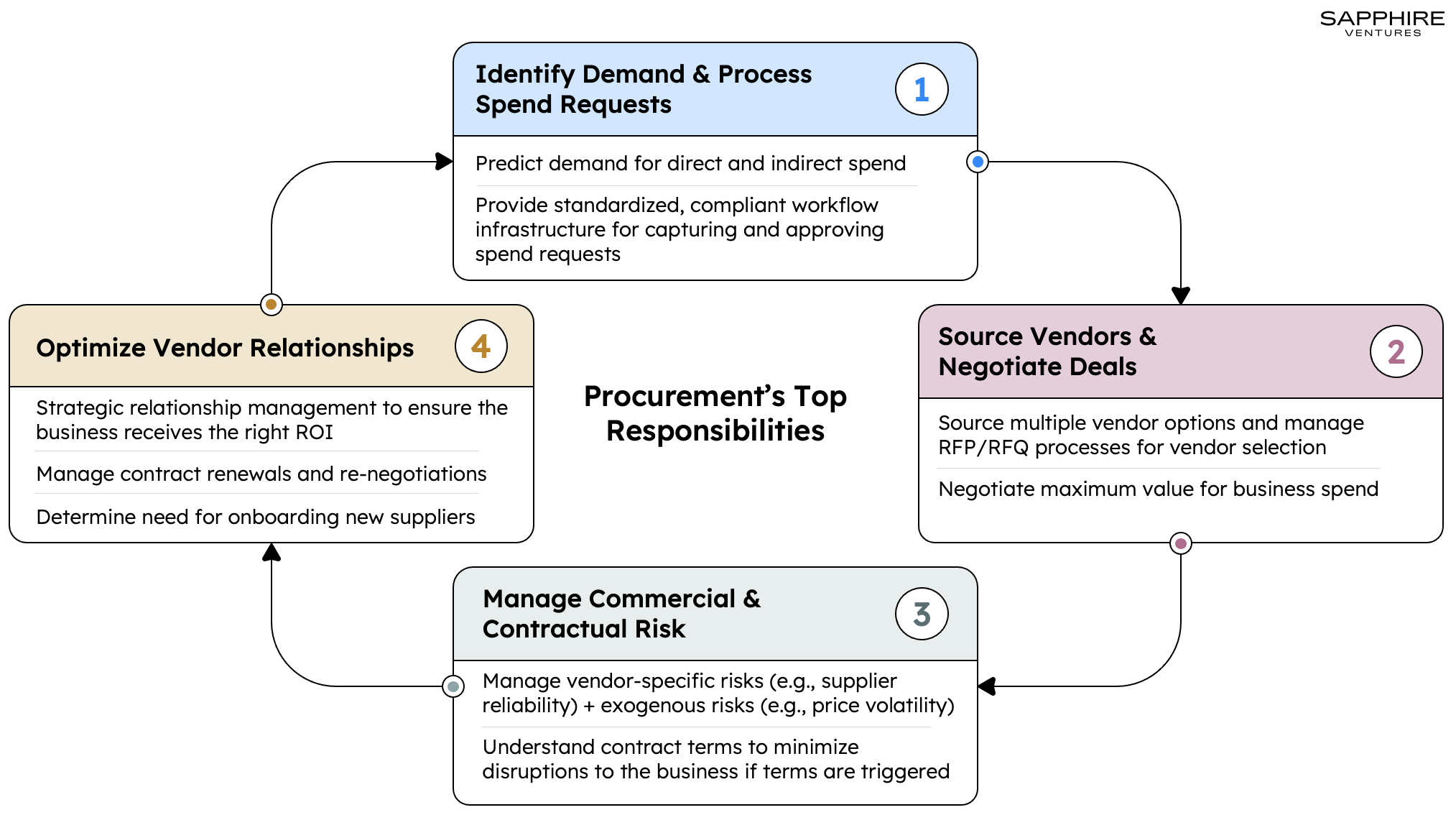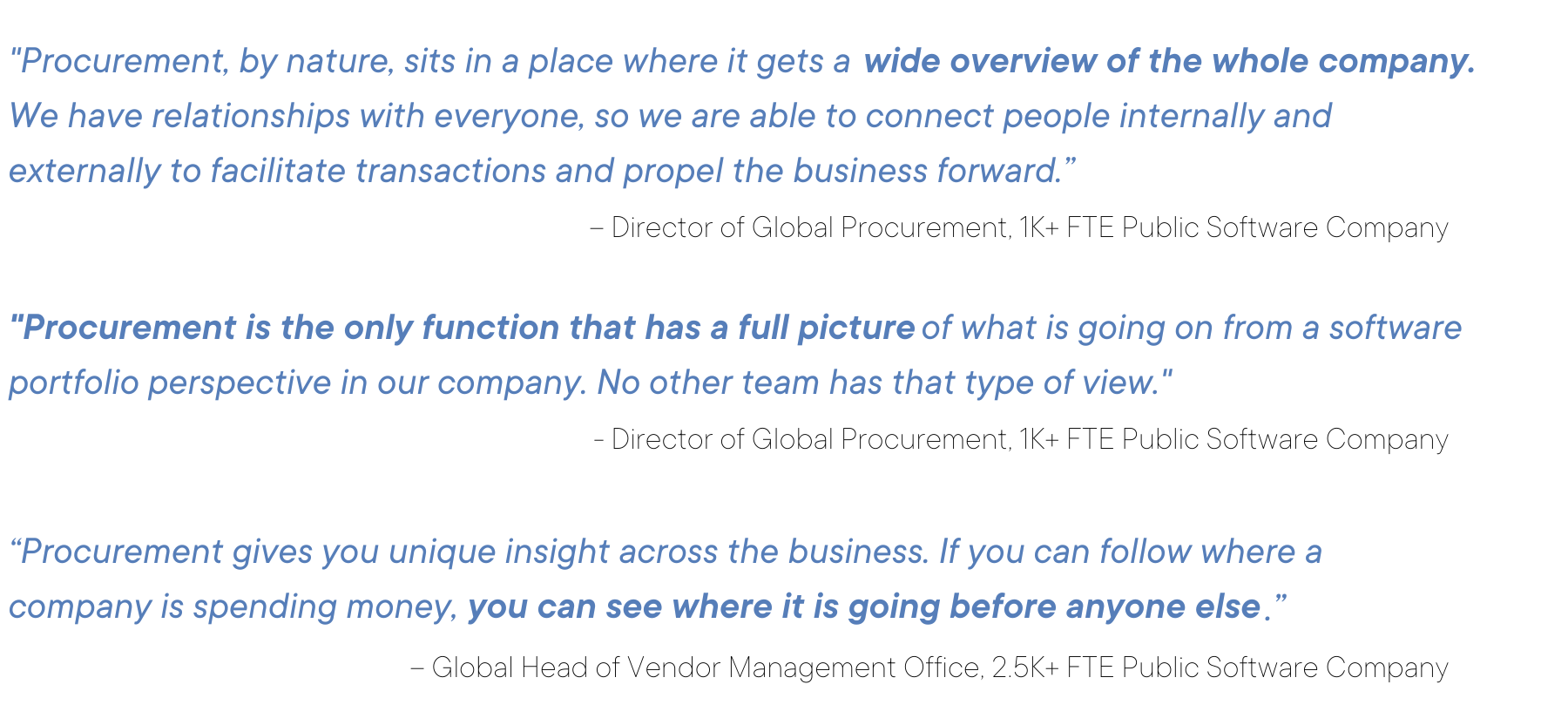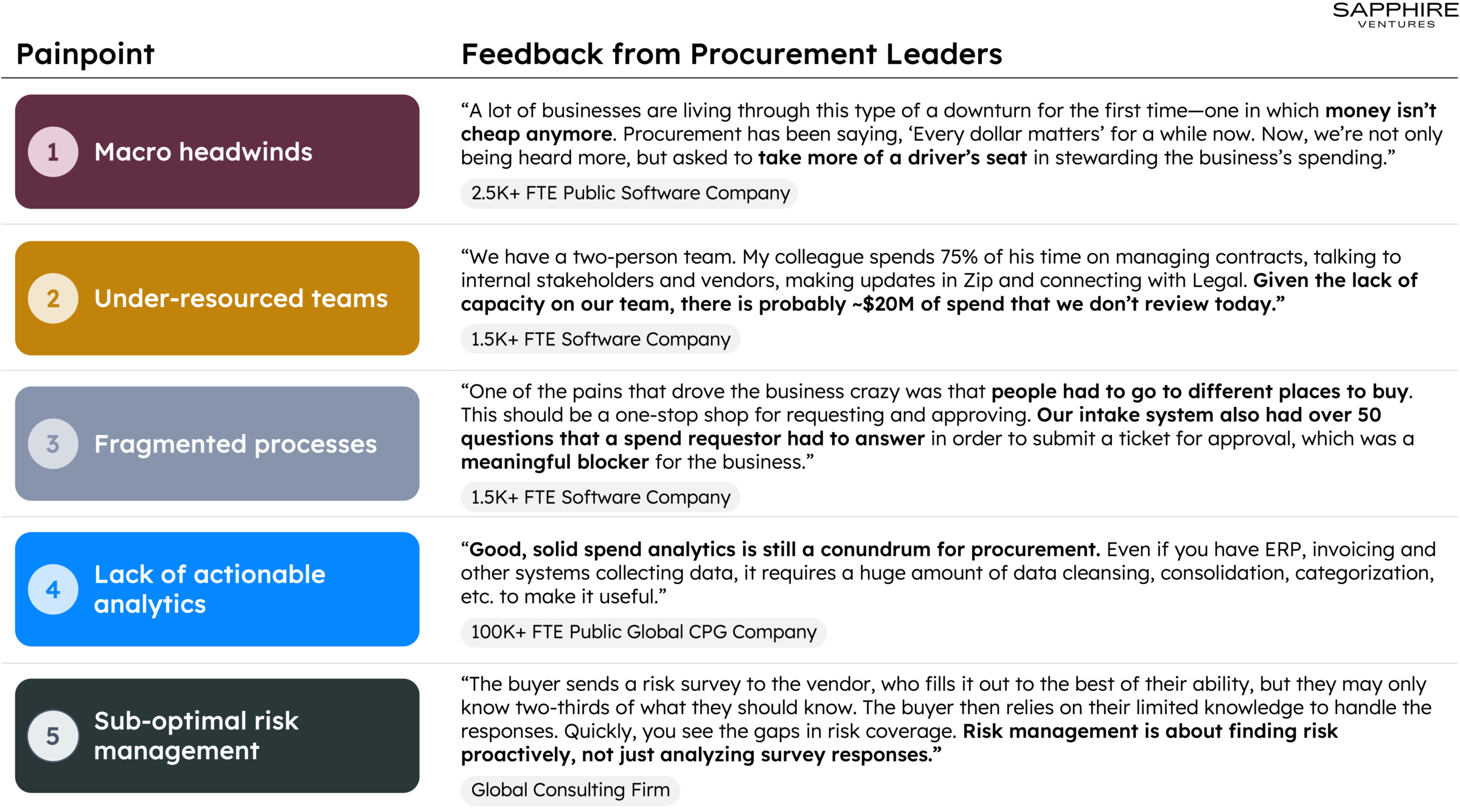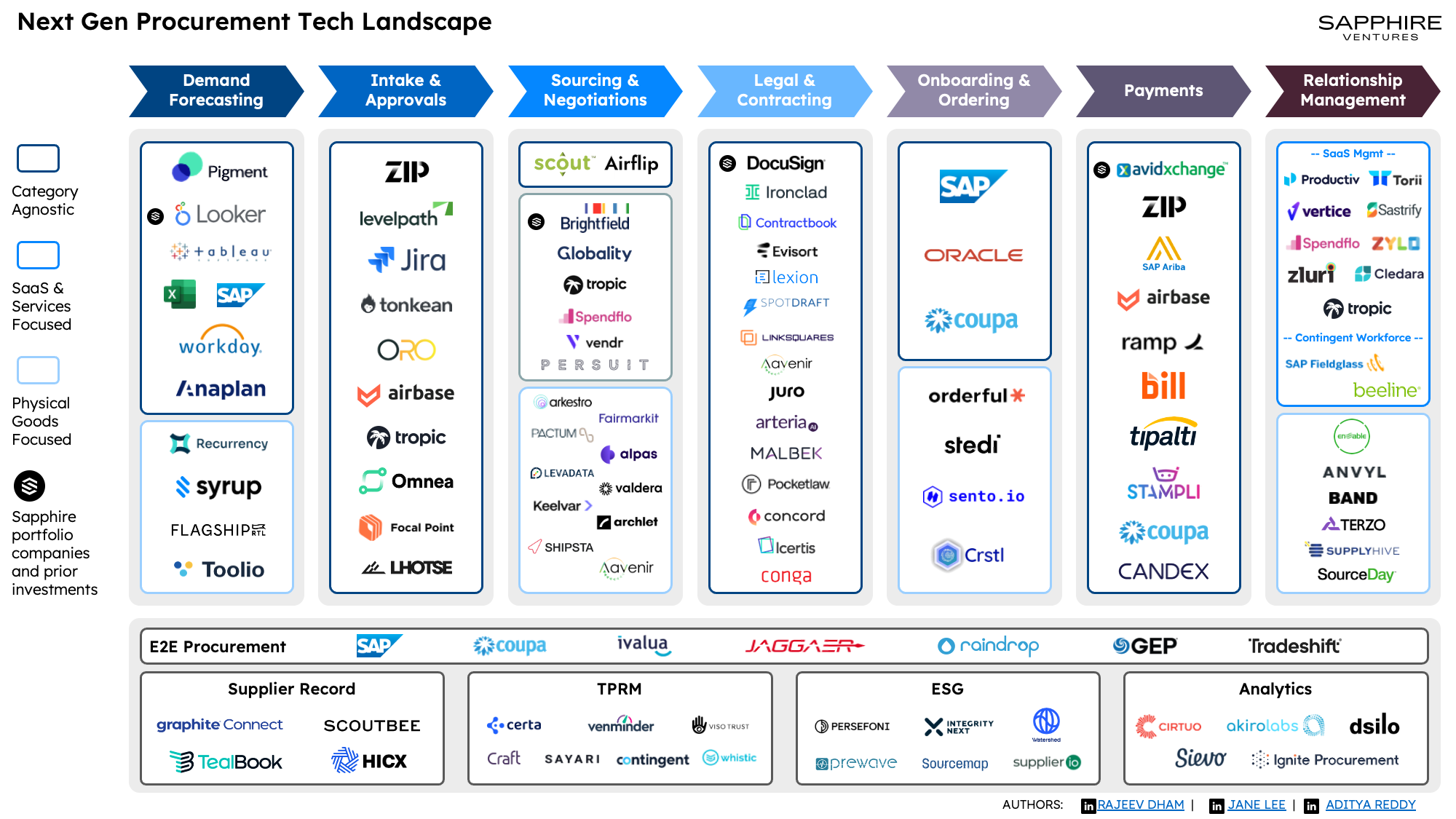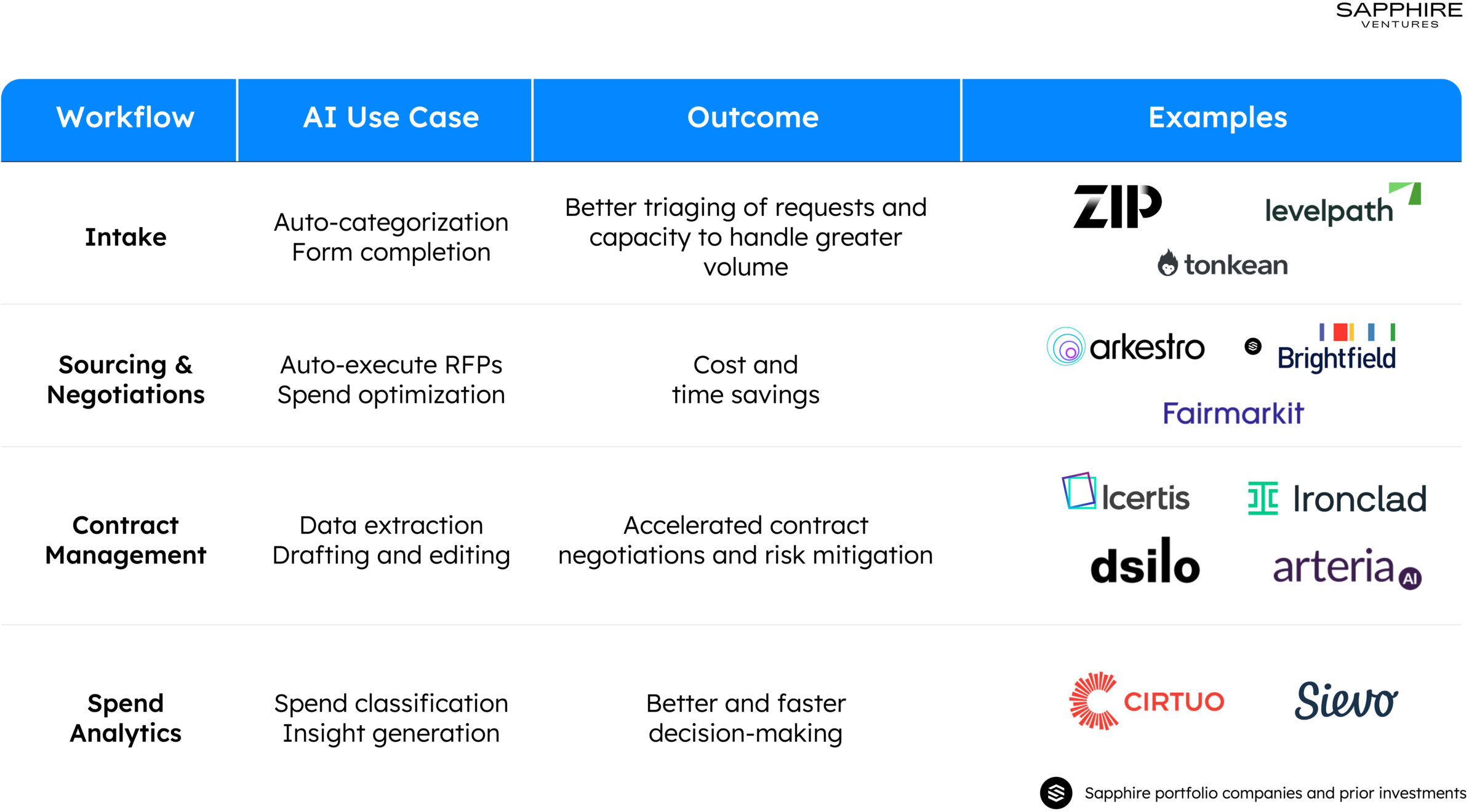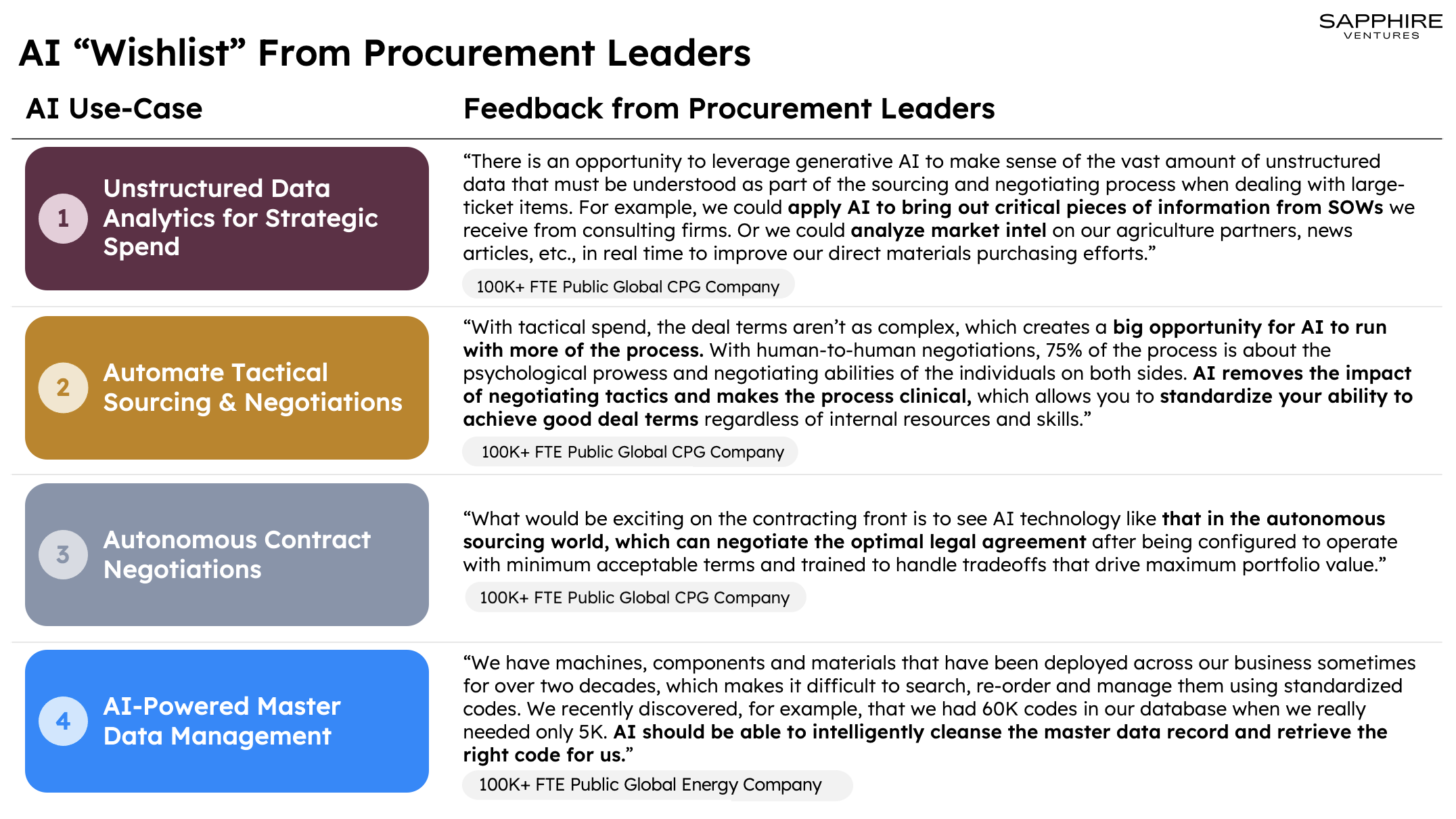The Batman movie had it backwards: you either die a villain or live long enough to see yourself become the hero. Procurement, once an underappreciated and even feared function, has stepped into the spotlight as the newest superpower for efficient growth.
We sat down with seasoned procurement leaders from PepsiCo, Shell, Blue Diamond Growers, Kearney, New Relic, JFrog (an exited Sapphire Ventures portfolio company), 6sense (a Sapphire Ventures portfolio company), Outreach (a Sapphire Ventures portfolio company) and more to discuss:
What is procurement?
Procurement is the team and set of processes that enable an organization to buy software, services and physical goods in order to execute its operating plan. Here are procurement’s key responsibilities:
Procurement: now a top strategic function
Procurement has become more influential than ever. As macroeconomic and geopolitical shocks rocked industries and capital markets in recent years, the importance of efficient spend and maintaining supply chain resilience and visibility has risen dramatically.
Here’s what some of the procurement leaders we surveyed said about how their teams have evolved into drivers of growth:
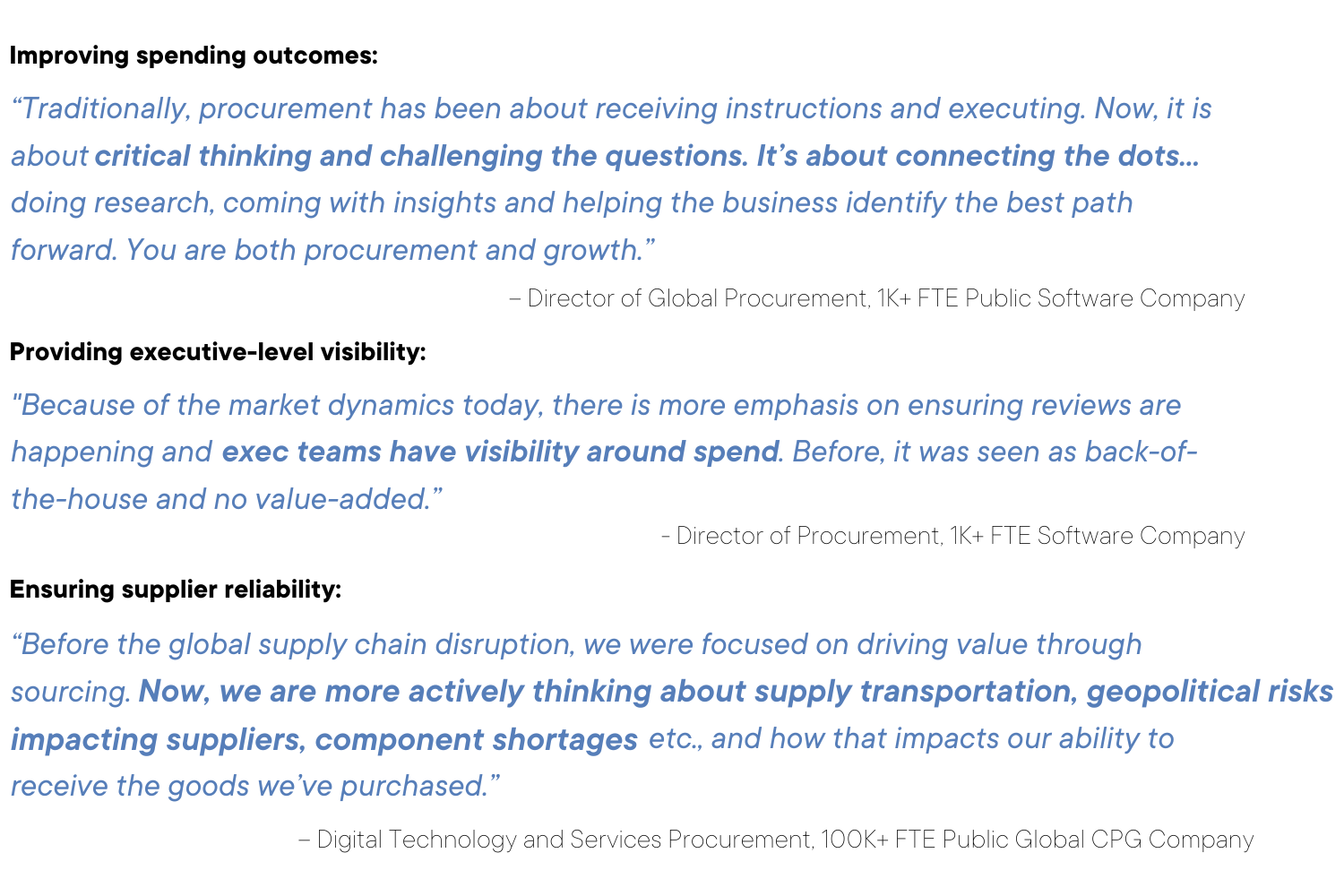
Growing pains: more responsibilities, same resources
While procurement has gained greater importance as an enabler of growth, the resources and technology it needs have lagged behind, creating challenges for procurement leaders:
The next-gen procurement software market
In response to the growing pains procurement is facing, a plethora of technology applications have emerged seeking to improve each step of the procurement workflow.
Over the past two decades, procurement tech has evolved from point solutions (i.e., FreeMarkets, Webango, diCarta in the early 1990s and 2000s) to multi-product suites (i.e., SAP Ariba, Coupa) that address the end-to-end needs of procurement teams. Today, with procurement gaining recognition as a growth engine and mission-critical function, organizations are looking for high-impact, best-of-breed procurement enablement technologies. See the procurement software market landscape below.
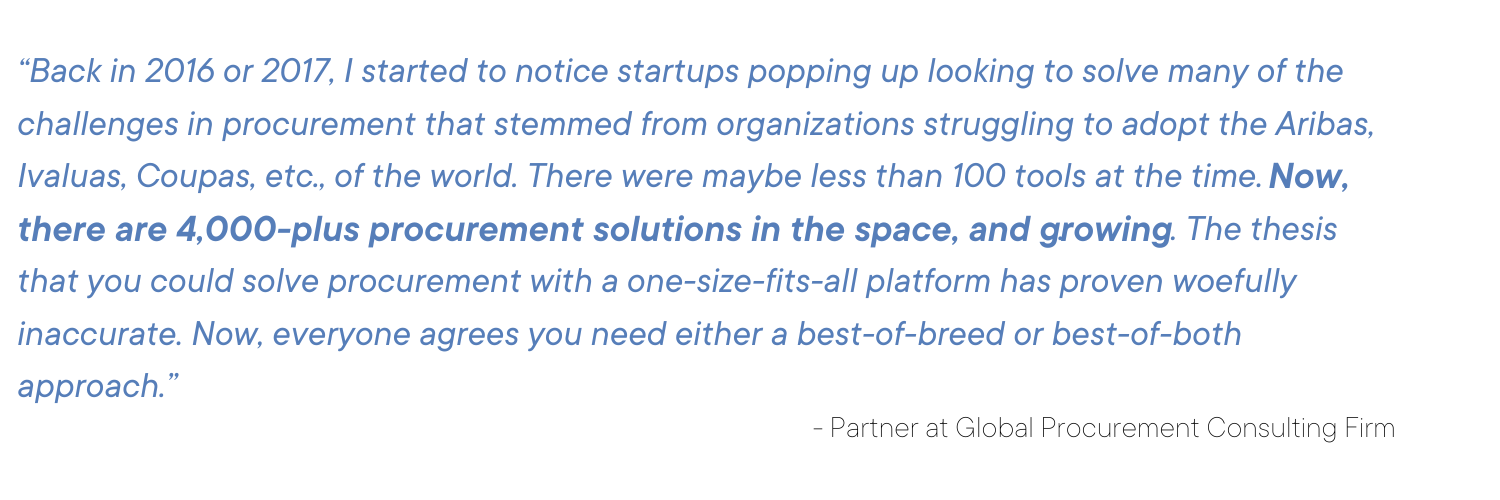
Demand forecasting
Business planning tools, such as Anaplan, Adaptive (Workday) and Pigment, help finance, procurement and other teams assess historical performance and project future growth in order to understand what spend they should unlock and its impact on the business. General-purpose BI tools, such as Looker (an exited Sapphire ventures portfolio company) and Tableau, as well as tried-and-true spreadsheets help procurement teams further analyze business data to determine demand, capacity to spend and the impact of deploying capital. For businesses purchasing physical goods, tools like Recurrency help teams intelligently forecast demand and streamline purchase order entry to eliminate stock-outs and optimize profits.
Intake and approvals
Once the business identifies a need to spend, organizations must facilitate an intake and approvals process to ensure resources are deployed in a strategic and compliant manner. Most businesses configure tools like Google Forms and Jira to hack together an intake questionnaire and multi-party approval workflow. As more employees across the organization gain the ability to request spend and the number of teams involved in approvals increases, organizations require a modern, end-to-end workflow orchestration engine that allows employees to easily input and track spend requests and reviewers to approve requests using their UI/UX of choice. Platforms like Zip, Levelpath and ORO provide a conditional and dynamic spend request questionnaire, out-of-the-box integrations with core tools used by IT, Legal and Compliance, etc. to review requests (i.e., Ironclad, Jira, etc.) and collaboration tools to accelerate the full request/approvals cycle.
Sourcing and negotiations
Sourcing and negotiations tools equip procurement teams with the data and workflow automations to efficiently achieve optimal deal terms. Systems like Scout (Workday) help organizations manage RFP processes for all types of spend at scale. When engaging with external labor agencies or third-party services firms, procurement teams can lean on comprehensive price and talent data from market intel platforms like Brightfield (a Sapphire Ventures portfolio company) and AI-powered proposal comparison capabilities from platforms like Persuit. For businesses purchasing direct materials, AI-powered tools like Arkestro, Fairmarkit, Keelvar and Pactum help procurement teams automate supplier negotiations and arrive at optimal deal terms across their entire portfolio without scaling up procurement resources proportionally.
Legal and contracting
Legal and contracting tools own the entirety of the vendor contract lifecycle, from drafting key terms and conditions to counterparty collaboration and contract redlining to serving as the internal contract repository. This category includes end-to-end CLM platforms like Ironclad, Evisort, Malbek and Icertis, as well as more focused solutions for functions like electronic signature (e.g., DocuSign, an exited Sapphire Ventures portfolio company).
Onboarding and ordering
Once procurement teams sign a contract, they then create the purchase order through their ERP – such as SAP – in which they outline the order details including supplier info, price, quantity, payment terms, etc. For repeat orders, organizations can hook into the appropriate order management systems of their supplier to facilitate programmatic ordering. Electronic Data Interchange (EDI) platforms like Orderful, Stedi and Crstl standardize ordering system integrations to allow buyers and their trading partners to go live within days of signing a contract.
Payments
Payment tools help Accounts Payable and Finance teams ensure invoices are accurate and payment for goods and services is delivered in a timely fashion. AP automation systems like AvidXchange (an exited Sapphire Ventures portfolio company), Bill.com, Ramp and Airbase help orchestrate the procure-to-pay process.
Relationship management
Once a vendor is onboarded, procurement teams must manage the relationship to ensure that the business continues to receive value and to find opportunities to optimize the relationship. SaaS management platforms like Productiv, Torii and Spendflo help organizations track SaaS licenses and usage, while tools like Beeline provide visibility into an organization’s contingent workforce. Rebate management tools like Enable and Band offer robust rebate calculation and forecasting software to help enterprises administer innovative and sophisticated rebates while ensuring maximum rebate revenue collections from their suppliers.
Supplier record
The CRM houses customer information, and the HRIS contains employee information. But what system manages supplier information? While the ERP is often used as the core supplier database, next-generation supplier information management platforms like GraphiteConnect and Tealbook aggregate a broader set of supplier data, including supplier catalog, geographic reach and ethical practices.
Third-party risk management
Third-party risk management (TPRM) platforms help organizations identify, evaluate and manage risks from external parties, including vendors. Platforms like Certa provide end-to-end risk management capabilities—risk scoring, alerting and ongoing monitoring and workflow automation—across information security, privacy, resiliency and more. Sayari provides organizations with traceable ownership and influence data, comprehensive sanctions lists and other tools to specifically diligence business relationships. To evaluate security documentation, businesses can turn to vendor assessment platforms like Whistic, which offer standardized assessment questionnaires, vendor intake forms and scoring methodologies, along with vendor collaboration tools to streamline the review process.
ESG
A large crop of modern software tools has emerged to support corporate ESG initiatives. Persefoni provides a climate management platform to help organizations manage carbon accounting and decarbonization planning, in part by aggregating carbon footprint data—including from suppliers—into one interface. Prewave analyzes millions of data sources to find and categorize supplier sustainability risks and facilitates communication to resolve the identified problem. Sourcemap automates supplier engagement across an organization’s supply chain in order to assess the risk and impact of each external party.
Analytics
Analytics tools enable procurement teams to better support the spend decision-making process. As organizations scale, procurement teams often employ a category management approach, grouping spend by category, such as “software”. Cirtuo leverages AI to analyze spend data, supply/demand balances, internal business requirements, risk and other factors to help procurement teams implement a category management strategy. For businesses looking to stay on top of commercial and legal terms in their contracts, dSilo’s AI technology analyzes contract line items, payment terms, SOWs, invoices and other relevant documents for procurement workflows.
E2E procurement
End-to-end procurement platforms, such as Coupa, Ariba, Ivalua and Jaggaer, give organizations a complete view of their spend, connect buyers and sellers across key aspects of the transaction through a single interface and streamline core components of the procurement value chain (i.e., strategic sourcing, contract management, supplier relationship management, spend analytics, etc.). While many of these vendors provide the most comprehensive functionality in the procurement world today, they are complex to implement and often leave teams wanting more from each module.
AI meets procurement
As a function with troves of structured and unstructured data and limited resources to make sense of it, procurement is well-positioned to benefit from recent advances in AI.
Here are a few examples of how procurement technology companies are leveraging AI to deliver tangible impact:
Here’s what founders had to say about how AI will transform procurement:
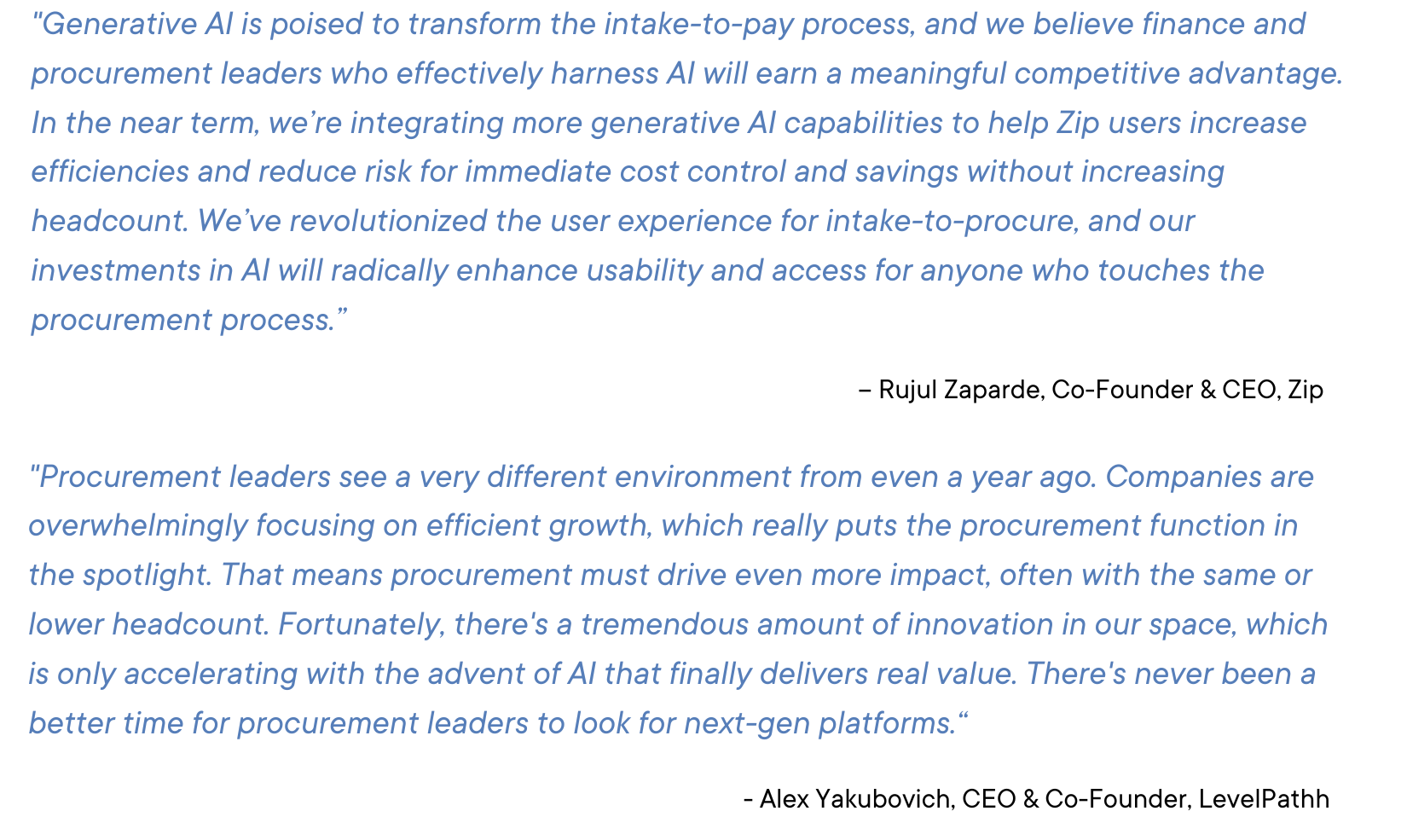
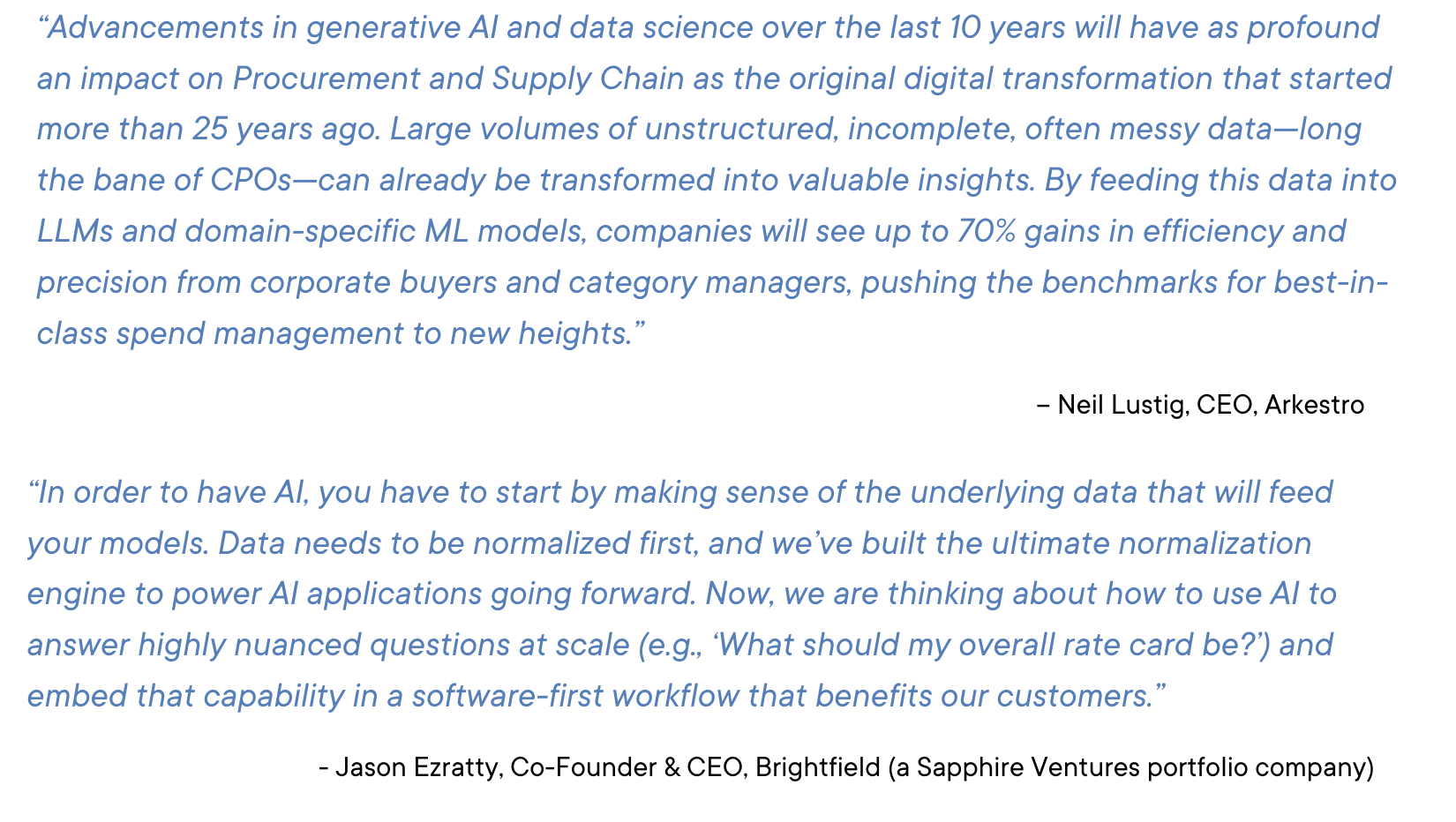
While excitement about AI in procurement is higher than ever, we are still in the early innings. There are still countless areas in procurement that can be measurably improved with the help of AI. For founders building tools in this domain, below are some AI capabilities that procurement leaders are looking for:
The future of procurement
As organizations operate amid economic uncertainty, procurement teams will continue to gain significant influence in the spend decision-making process. We at Sapphire believe there is an incredible opportunity for technology to supercharge the procurement team’s core workflows, provide deep spend insights and enable cross-functional collaboration.
If you are working to address this opportunity, please reach out to Rajeev at [email protected], Jane at [email protected] and Adi at [email protected]. We look forward to hearing from you!
Thanks to Alex Yakubovich, Anthony Moon, Barry Rogers, Bill Browning, Coe Hawkins, Dr. Elouise Epstein, Fraser Hill, Jason Ezratty, Kindra Putnam, Neil Lustig, Ravit Ben David, Remko Tersteeg, Rujul Zaparde, Steve Birgfeld and Steve Schult for your feedback



